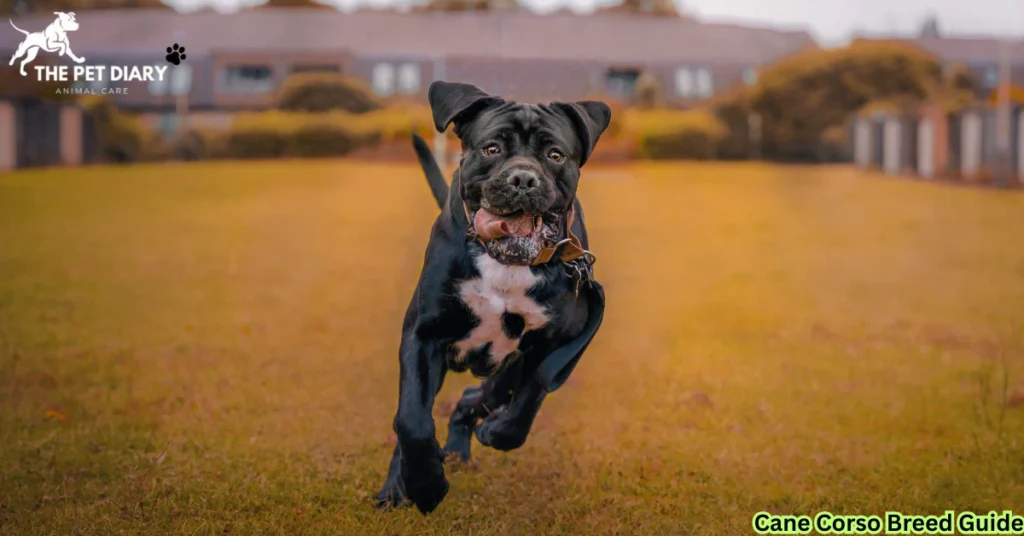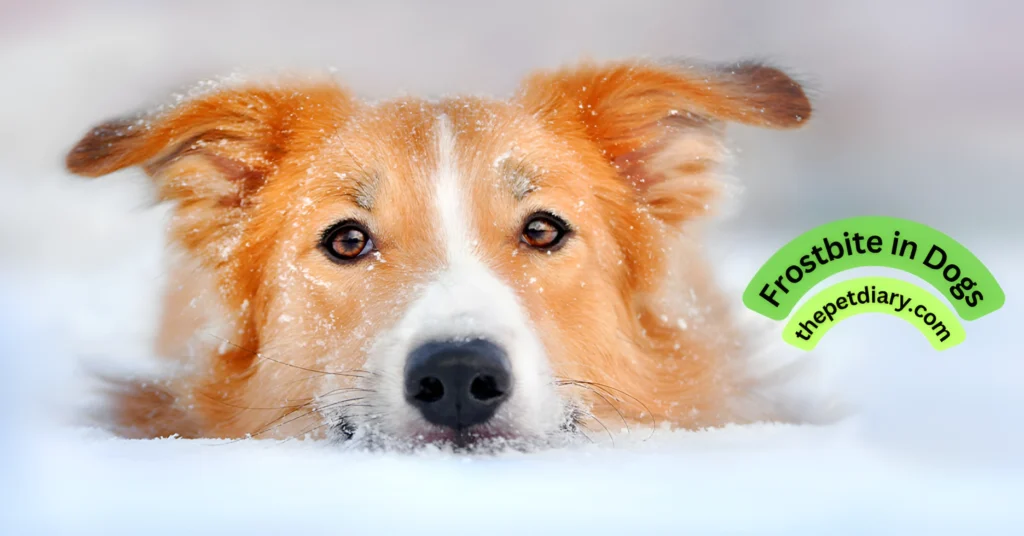The Cane Corso is a magnificent Italian mastiff celebrated for its intelligence, loyalty, and striking appearance. At the first sight of cane corso puppies, you’ll notice their confident stance and soulful eyes. Whether you are drawn to a black cane corso for its classic elegance or curious about rarer shades, this breed consistently turns heads. Bred as guardians of property and livestock, Cane Corsos are affectionate with their families yet naturally protective. This Cane Corso Breed Guide explains everything you need to know from colors and health to costs and training, so you can decide if this powerful dog is right for you.
A Brief History of the Cane Corso
Originating in ancient Italy, the Cane Corso descends from the Roman war dog known as the Canis Pugnax. These dogs accompanied soldiers in battle and later worked as hunters and farm guardians. Over time, they became indispensable for protecting property and herding animals.
Today’s Cane Corso retains that courageous spirit while adapting well to modern family life when properly socialized.
Physical Characteristics & Cane Corso Colors
Cane Corsos are athletic, muscular dogs with a regal stance. Males typically weigh 100–120 lb (45–54 kg) and stand 25–27 in (63–68 cm) tall, while females are slightly smaller. Their short, dense coat is easy to maintain and comes in a fascinating range of shades.
Below is a handy table highlighting recognized cane corso colors, including some rare favorites such as the blue cane corso and the elusive white cane corso (sometimes called cane corso white).
| Color | Description | Popularity |
|---|---|---|
| Black Cane Corso | Classic jet-black coat; enhances the breed’s striking look | Very common |
| Blue Cane Corso | Steel-gray coat that appears bluish in sunlight | Rare |
| Fawn | Warm beige with black mask | Common |
| Red | Rich rust or mahogany hue | Less common |
| Chestnut Brindle | Dark stripes over a chestnut base | Uncommon |
| White Cane Corso | Extremely rare; may have cream or pale markings | Very rare |
| Merle Cane Corso | Mottled pattern; not a standard color, and may indicate crossbreeding | Rare/controversial |
Tip: While colors like merle cane corso or white cane corso are eye-catching, always verify the breeder’s ethics. Some rare hues can signal non-standard breeding practices.
Related Post:Rhodesian Ridgeback: Temperament, Traits & Daily Care
Temperament and Personality
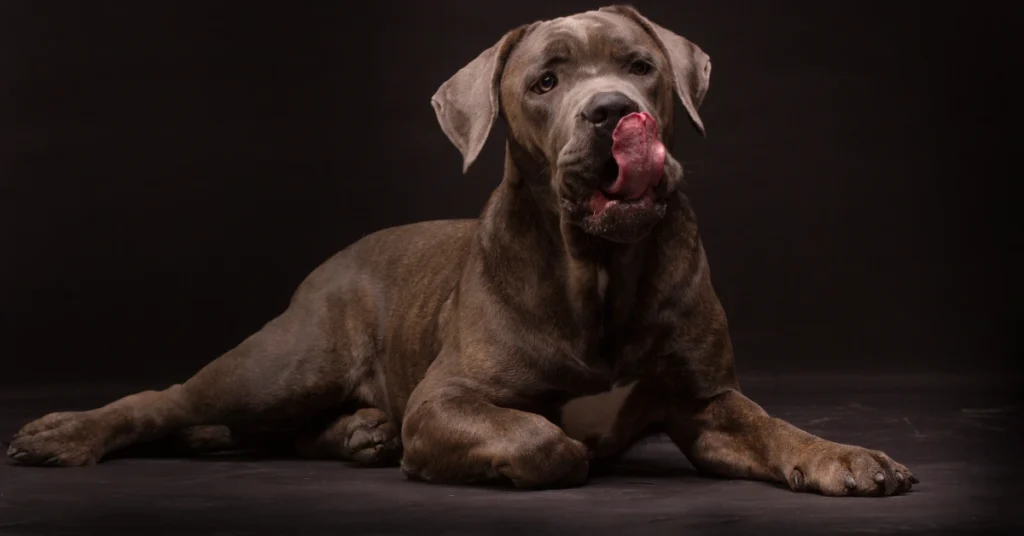
Despite their formidable looks, Cane Corsos are affectionate family dogs. They bond closely with their owners and are eager to please, making them trainable yet strong-willed.
Key traits include:
-
Protective Nature: Natural guardians who instinctively watch over children and property.
-
Intelligence: Quick learners who respond well to positive reinforcement.
-
Confidence: Calm and self-assured without unnecessary aggression when properly socialized.
Because they are powerful, early training and socialization are essential. Introduce cane corso puppies to different environments, people, and pets early on to help them grow into well-mannered adults.
Care and Training Essentials
Cane Corsos require both mental stimulation and physical exercise. A bored dog may become destructive, so aim for at least 60–90 minutes of daily activity, including brisk walks, obedience drills, or agility exercises.
Training Tips
-
Consistency is Key: Start obedience training the day your cane corso puppy comes home.
-
Positive Reinforcement: Reward good behavior with treats or praise.
-
Proper Gear: A strong, well-fitted cane corso collar provides control without discomfort.
Professional obedience classes can help reinforce your training, especially for first-time large-breed owners.
Health and Life Expectancy
Overall, Cane Corsos are robust, but like all large breeds, they are prone to certain issues:
-
Hip and elbow dysplasia
-
Heart conditions such as dilated cardiomyopathy
-
Eye problems like cherry eye
The typical Cane Corso life expectancy ranges from 9 to 12 years. If your dog is mixed with another mastiff, the cane corso mastiff’s life expectancy can be similar, but may vary depending on genetics and care.
Regular vet check-ups, a balanced diet, and weight management significantly reduce the risk of common cane corso health issues.
Here’s a quick comparison of life spans:
| Breed Type | Average Life Expectancy |
|---|---|
| Purebred Cane Corso | 9–12 years |
| Cane Corso Mastiff (mix) | 8–11 years |
Note: High-quality nutrition and regular exercise are key factors in extending your Cane Corso’s healthy years.
Feeding and Exercise Needs
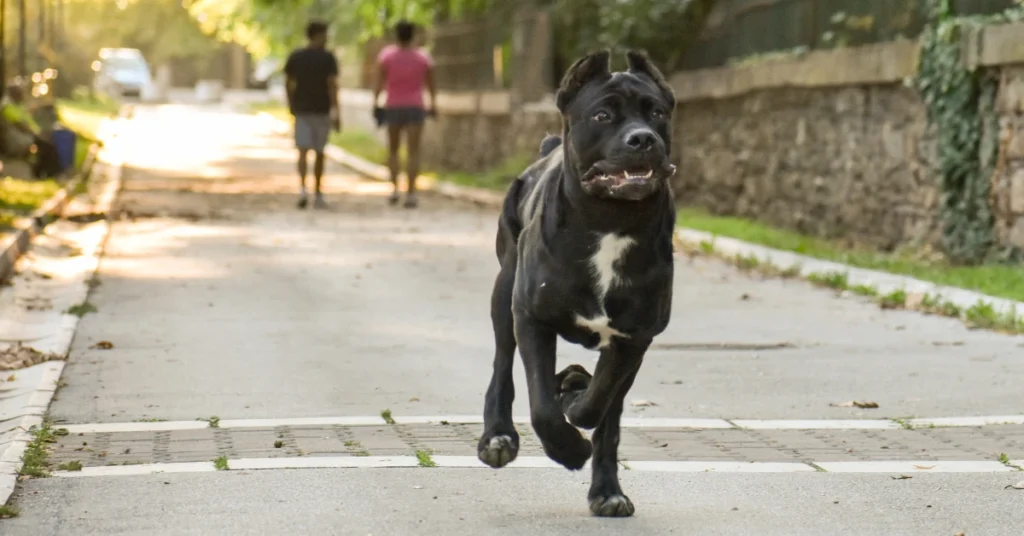
Feed a high-protein, large-breed formula to support muscle development. Puppies benefit from three smaller meals per day, while adults thrive on two balanced meals.
Cost of Ownership: How Much Is a Cane Corso?
Owning a Cane Corso is an investment in both time and money. Before bringing home one of these majestic dogs, it’s wise to understand the full financial picture.
Initial Purchase Price
The cane corso price varies widely depending on pedigree, breeder reputation, and location:
| Source | Typical Cost (USD) |
|---|---|
| Reputable Breeder (pet quality) | $1,200–$2,500 |
| Show/Breeding Lines | $3,000–$5,000+ |
| Cane Corso Adoption (rescue) | $200–$600 |
When people ask, “How much is a cane corso?”, the above ranges provide a realistic estimate. Adoption from a rescue group can be an excellent way to save money and give a loving home to a dog in need.
Ongoing Annual Expenses
-
Food: $800–$1,200 (high-protein large-breed diet)
-
Vet Care: $400–$700 for routine visits and vaccinations
-
Training & Socialization: $300–$600
-
Grooming & Supplies: $200–$400 (including strong cane corso collars)
Budgeting around $2,000–$3,000 per year ensures your Cane Corso Dog lives a healthy, comfortable life.
Adoption vs. Buying from a Breeder
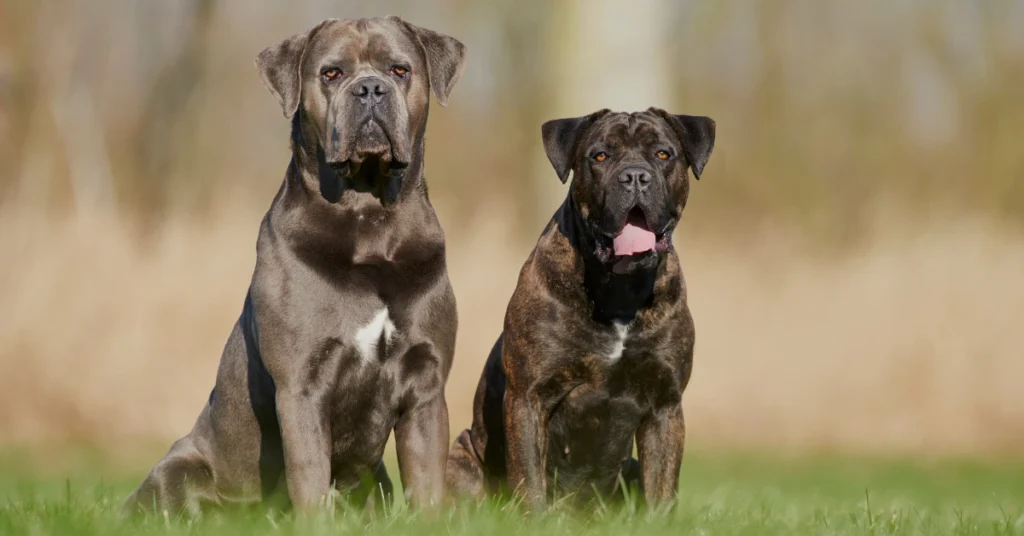
Cane Corso Adoption
Adopting is a compassionate choice that often provides a second chance for dogs surrendered due to lifestyle changes, not behavioral issues. Rescue organizations screen for health and temperament, so you can find both adult dogs and playful cane corso puppies in need of homes.
Buying from a Breeder
If you choose a breeder, verify:
-
Health certifications (hips, heart, eyes)
-
Socialization practices
-
Transparent lineage records
Whether you choose a female cane corso or a male, prioritize responsible breeding to avoid genetic cane corso health issues.
Popular Cane Corso Mix Breeds
Mixes can bring unique looks and temperaments while often improving genetic diversity. Below are some eye-catching crosses.
Cane Corso and Pitbull Mix
This blend combines the Cane Corso’s guarding instinct with the Pitbull’s energetic, affectionate personality. Expect a powerful, medium-to-large dog with strong loyalty and high exercise needs.
Cane Corso Rottweiler Mix
The cane corso rottweiler mix produces a confident guardian with exceptional intelligence. Early socialization is critical to channel their protective nature into well-mannered behavior.
Cane Corso German Shepherd Mix
A Cane Corso German Shepherd mix often inherits the German Shepherd’s trainability and the Cane Corso’s imposing size. These dogs thrive in active homes with experienced owners.
Tip: With any mix, research both parent breeds carefully to understand potential temperament and health considerations.
Understanding the “King Cane Corso” Dogs
You may encounter the term king cane corso dogs in online ads or breeder marketing. This phrase usually refers to oversized Corsos bred for impressive size.
While a larger dog might seem appealing, extra weight can shorten the cane corso’s life expectancy and increase the risk of joint problems. Responsible breeders prioritize health and correct structure over exaggerated size.
Essential Gear for a Cane Corso
Because of their strength, quality equipment is a must:
-
Heavy-duty cane corso collars and harnesses
-
Strong chew toys for mental stimulation
-
Elevated feeding bowls to promote healthy posture
Durable products prevent accidents and provide comfort during training.
Grooming and Maintenance
Cane Corsos are low-maintenance when it comes to grooming, thanks to their short coat:
-
Brushing: Weekly brushing keeps shedding under control.
-
Bathing: Every 6–8 weeks or when dirty.
-
Nail Trimming: Monthly to prevent cracking.
Check ears weekly and brush teeth several times a week to prevent infections and maintain overall health.
Socialization and Family Life
When properly trained, a Cane Corso can be a loving companion for families:
-
Children: Gentle but protective with kids; supervision is essential due to size.
-
Other Pets: Early exposure helps them coexist peacefully with other animals.
Invite guests regularly and enroll your cane corso puppy in obedience classes to nurture a friendly, balanced temperament.
Advanced Training Ideas
After mastering basic commands, try advanced activities:
-
Agility Courses: Great for building coordination.
-
Scent Work: Stimulates their powerful sense of smell.
-
Guard Work: If desired, professional guidance ensures safe, controlled protection training.
Such mental challenges keep the breed engaged and prevent boredom-related behaviors.
Traveling with a Cane Corso
Planning vacations or road trips? Consider these tips:
-
Crate Training: Provides safety and comfort during car rides.
-
Frequent Breaks: Large dogs need regular stops to stretch.
-
Identification: Ensure your Cane Corso collars include updated ID tags.
Health Monitoring and Vet Care
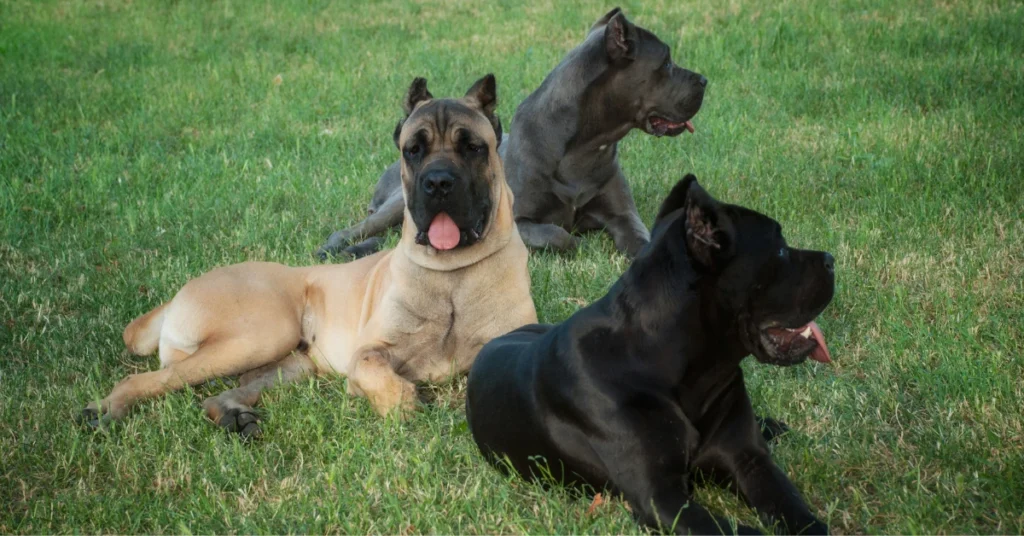
Routine veterinary care is essential. Schedule:
-
Annual physical exams and vaccinations
-
Dental cleanings as recommended
-
Screening for elbow/Hip dysplasia and heart health
Because cane corso health issues like cardiomyopathy can be silent, periodic heart checks can be life-saving.
Exercise: Keeping the Athlete in Shape
As natural athletes, Cane Corsos need a mix of strength and endurance activities:
-
Daily brisk walks or runs
-
Play sessions in a secure yard
-
Interactive games such as fetch or tug
Aim for 60–90 minutes of vigorous exercise per day to support muscle tone and joint health.
Feeding Your Cane Corso: Nutrition That Fuels Strength
A well-balanced diet is critical for a large, muscular breed like the Cane Corso Dog. High-quality nutrition promotes joint health, supports the immune system, and helps maintain a shiny coat in every color from the striking black cane corso to the rare blue cane corso.
Puppy Stage
Cane corso puppies grow rapidly and need a specially formulated large-breed puppy food to prevent joint problems. Divide meals into three portions per day to aid digestion and avoid bloat.
Adult Stage
Switch to an adult large-breed formula at about 12–14 months. Feed twice daily to maintain stable energy levels.
Key nutrient targets:
-
Protein: 25–28% for muscle maintenance
-
Fat: 12–15% for energy
-
Glucosamine & Chondroitin: Supports hips and elbows
Senior Stage
As dogs age, calorie needs decline. Choose a senior formula rich in omega-3s and joint-support supplements to prolong the Cane Corso’s life expectancy.
Special Considerations for Cane Corso Mixes
Because mixes can have different nutritional and activity requirements, tailor feeding plans carefully.
-
Cane Corso and Pitbull Mix: Generally more energetic, may need slightly higher calories.
-
Cane Corso Rottweiler Mix: Prone to hip issues; glucosamine supplementation is vital.
-
Cane Corso German Shepherd Mix: Typically very active; balanced protein to fat ratios help maintain ideal weight.
Regardless of mix, always provide fresh water and monitor weight to reduce the risk of obesity-related cane corso health issues.
Exercise Routines for Every Life Stage
The Cane Corso thrives on both mental and physical activity. Below is a simple progression chart:
| Life Stage | Recommended Daily Activity |
|---|---|
| Puppy (3–12 months) | 2–3 short play sessions + basic training |
| Adult (1–6 years) | 60–90 minutes brisk walk/jog + advanced obedience |
| Senior (7+ years) | 30–45 minutes gentle walk + light puzzle games |
Tip: Over-exercising young cane corso puppies can damage growing joints. Gradually increase intensity as they mature.
Senior Care and Extending Life Expectancy
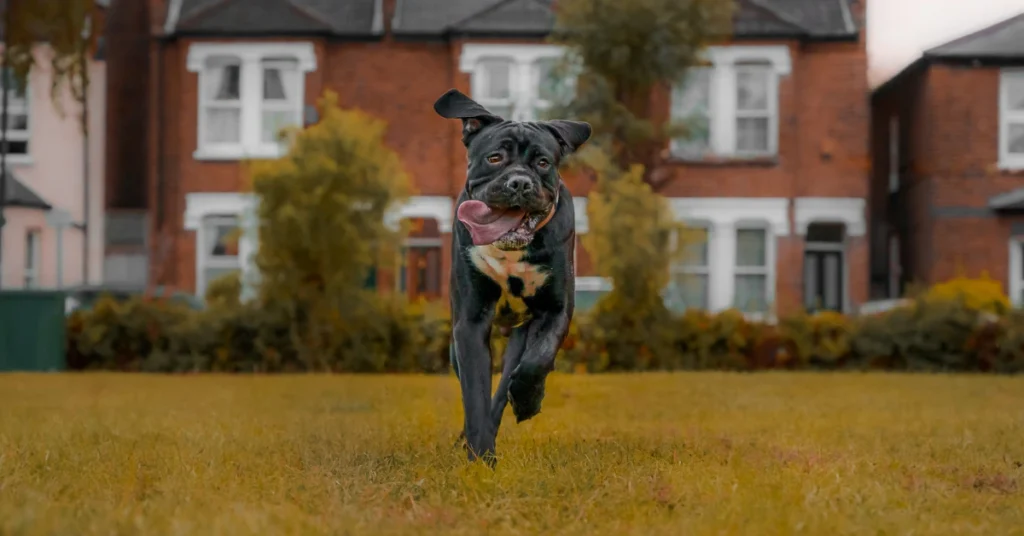
With proper care, many Cane Corsos live at the upper end of their Cane Corso mastiff life expectancy of 9–12 years.
Key Strategies
-
Regular Vet Visits: Twice-yearly checkups catch issues early.
-
Weight Management: Prevents strain on hips and heart.
-
Joint Support: Glucosamine and fish oil keep cartilage healthy.
-
Gentle Exercise: Keeps muscles strong without overtaxing joints.
Provide a soft bed and a calm environment to reduce stress as your companion ages.
Living Spaces: Urban vs. Rural
Despite their size, Cane Corsos can adapt to city life if exercised properly.
-
Urban Homes: Daily long walks, trips to dog parks, and secure fenced yards are essential.
-
Rural Properties: Perfect for a dog who loves to roam and guard. Provide training to prevent unwanted chasing of wildlife.
Regardless of the setting, these dogs require human interaction and should never be left to live outside full-time.
Traveling and Social Adventures
Cane Corsos love to be with their families, whether on road trips or outdoor adventures.
-
Car Safety: Use a crash-tested crate or harness.
-
Pet-Friendly Hotels: Check breed policies in advance; some listings specifically welcome large dogs.
-
Public Etiquette: Keep a firm grip on a sturdy cane corso collar and maintain obedience to ensure positive experiences.
Building a Strong Bond
A Cane Corso’s loyalty runs deep. Strengthen your connection with consistent routines and positive reinforcement.
-
Daily Training: Even 10-minute refreshers maintain obedience.
-
Interactive Play: Tug games and scent work engage both mind and body.
-
Affection: Despite their imposing look, these dogs crave love and thrive on praise.
Common Myths About the Cane Corso Dog:
“They’re Naturally Aggressive.”
False. A well-trained, socialized Cane Corso is calm and even-tempered. Aggression typically stems from neglect or poor training.
“Bigger Is Better: Get a King Cane Corso Dog.”
The idea of King Corso is mostly marketing. Oversized dogs may face increased joint stress and shorter lifespans.
“They Don’t Need Socialization.”
Every Cane Corso, from a tiny Cane Corso puppy to a senior, benefits from regular positive interactions with people and pets.
Quick Reference Checklist
Before bringing home a Cane Corso, confirm you can provide:
-
Space and secure fencing
-
Time for training and daily exercise
-
Budget for Cane Corso price, food, and vet bills
-
A strong, comfortable cane corso collar
-
Commitment to lifelong socialization
🐾Final Thoughts: Is the Cane Corso Dog Right for You?
The Cane Corso is a loyal protector and devoted family member. Whether you are drawn to the elegance of a black cane corso, the rarity of a blue cane corso, or the striking look of a merle cane corso, this breed demands dedication.
Key takeaways from our Cane Corso Breed Guide:
-
Personality: Intelligent, affectionate, naturally protective
-
Care Needs: High—daily exercise, consistent training
-
Health: Generally robust, but watch for joint and heart issues
-
Cost: Plan for the initial Cane Corso price plus annual expenses
If you can provide firm leadership, early socialization, and plenty of love, the Cane Corso will reward you with unwavering loyalty and a lifetime of companionship.📌 For more detailed guides & blogs, visit our website: www.thepetdiary.com
🐾Frequently Asked Questions (FAQs)
Q1: What is the average Cane Corso life expectancy?
A healthy Cane Corso typically lives 9–12 years, while mixes like the Cane Corso Mastiff may live around 8–11 years with proper care.
Q2: How much is a Cane Corso puppy?
The cane corso price from reputable breeders ranges from $1,200 to $2,500, while show-quality lines can cost $3,000 or more. Cane corso adoption fees are usually $200–$600.
Q3: Are Cane Corsos good family dogs?
Yes. With early socialization and consistent training, cane corso puppies grow into affectionate, protective, and loyal family companions.
Q4: What colors do Cane Corsos come in?
Recognized cane corso colors include black, fawn, red, brindle, and gray (blue cane corso). Rare hues like white cane corso or merle cane corso exist but are less common.
Q5: Do Cane Corsos have major health issues?
They are generally healthy but can face cane corso health issues such as hip dysplasia, heart disease, and eye conditions. Regular vet check-ups are essential.
-
